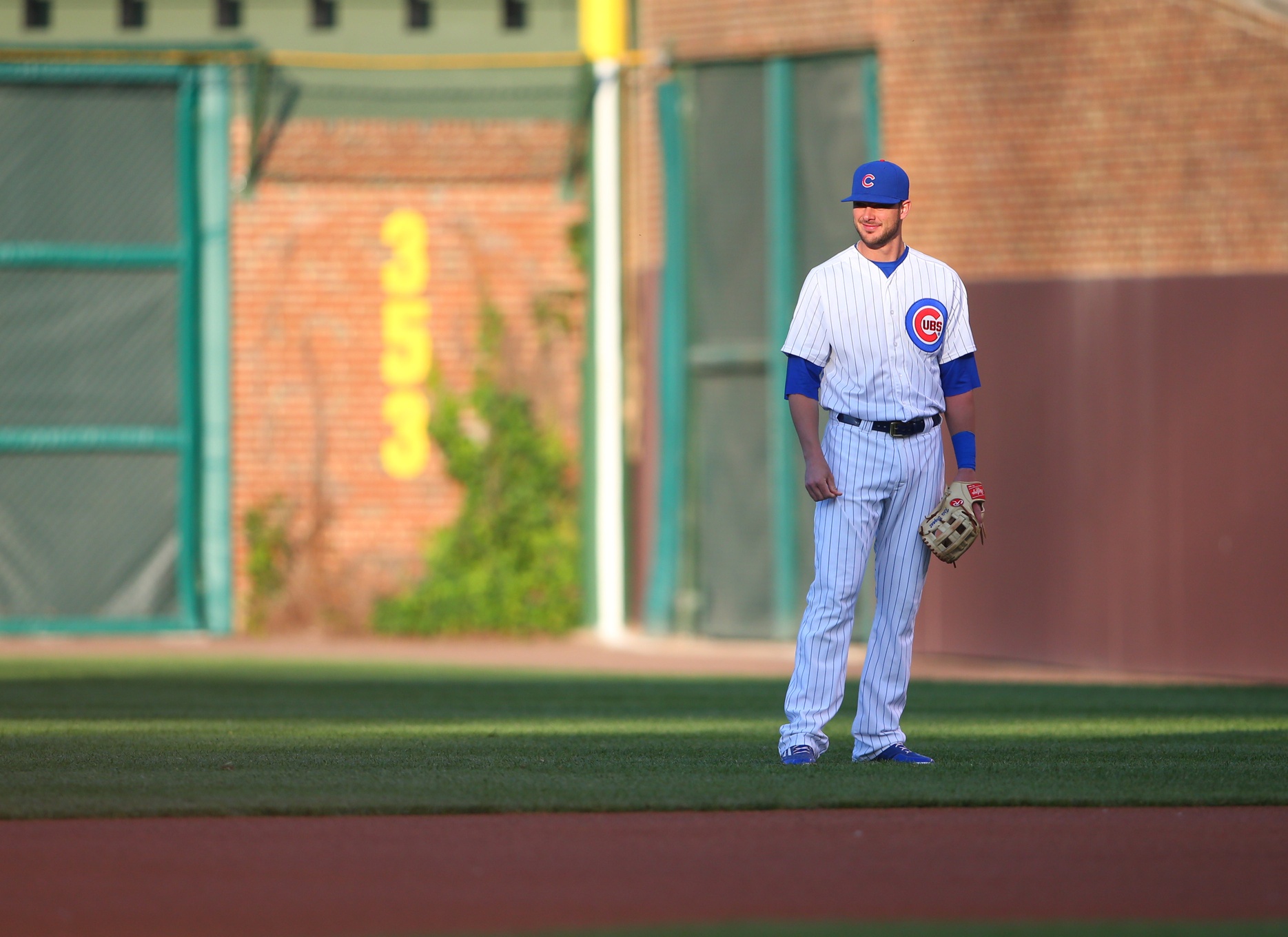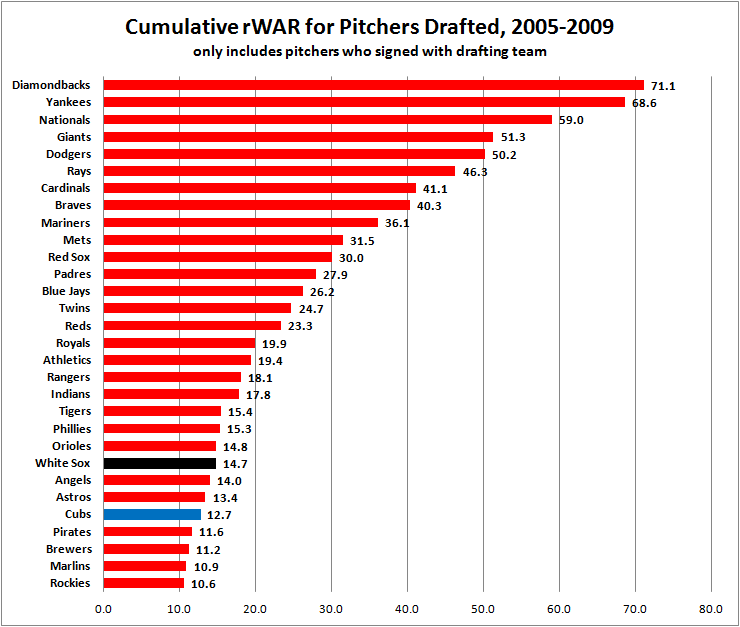The 2015 MLB draft occurred a couple weeks ago, and at this point everything is pure speculation. Cubs first-round pick Ian Happ is already fueling hype by hitting two home runs in his first five games through Tuesday at Eugene in the short-season Northwest League, but I’ll leave that to others to dream about what will come from that.
It’s foolish to evaluate drafts until several years have passed, and in the case of baseball, when the typical draftee is between 18 and 22, it takes a minimum of five years, and probably closer to seven, to truly know if a pick was successful or not. One way to evaluate how well teams have drafted is to look at the cumulative Wins Above Replacement value of the drafts, as well as the number of players who eventually made it to the majors. This chart shows how well teams have drafted using Baseball Reference’s WAR (rWAR) value for all draft picks between 2000 and 2009:
| Team | Picks | MLB | Pct | rWAR |
|---|---|---|---|---|
| Red Sox | 496 | 77 | 15.5% | 337.4 |
| Diamondbacks | 505 | 79 | 15.6% | 331.0 |
| Rays | 488 | 77 | 15.8% | 299.8 |
| Angels | 500 | 79 | 15.8% | 292.8 |
| Nationals/Expos | 498 | 73 | 14.7% | 271.7 |
| Brewers | 486 | 65 | 13.4% | 268.6 |
| Pirates | 485 | 64 | 13.2% | 263.6 |
| Braves | 515 | 76 | 14.8% | 262.0 |
| Dodgers | 484 | 75 | 15.5% | 240.5 |
| Athletics | 454 | 79 | 17.4% | 240.3 |
| Twins | 503 | 72 | 14.3% | 238.2 |
| Rangers | 493 | 68 | 13.8% | 227.8 |
| Cardinals | 492 | 80 | 16.3% | 222.5 |
| Rockies | 501 | 71 | 14.2% | 218.4 |
| Phillies | 480 | 66 | 13.8% | 210.5 |
| Cubs | 500 | 73 | 14.6% | 206.1 |
| Reds | 500 | 57 | 11.4% | 194.0 |
| Yankees | 500 | 76 | 15.2% | 190.8 |
| Giants | 498 | 83 | 16.7% | 184.2 |
| Royals | 496 | 54 | 10.9% | 179.8 |
| Tigers | 477 | 65 | 13.6% | 168.7 |
| Marlins | 491 | 60 | 12.2% | 155.6 |
| Padres | 464 | 78 | 16.8% | 154.7 |
| Indians | 506 | 65 | 12.8% | 152.2 |
| Astros | 471 | 53 | 11.3% | 146.2 |
| Mets | 485 | 52 | 10.7% | 141.9 |
| Mariners | 489 | 62 | 12.7% | 138.1 |
| Orioles | 487 | 53 | 10.9% | 116.7 |
| Blue Jays | 473 | 64 | 13.5% | 111.2 |
| White Sox | 497 | 64 | 12.9% | 94.0 |
The years chosen represent around 75 percent of active players. The Cubs are right in the middle of the pack in terms of players who reached the majors and the value they delivered.
Here are the better players chosen by the Cubs in this time span:
| Player | Year | Rnd | rWAR |
|---|---|---|---|
| Dontrelle Willis | 2000 | 8 | 20.3 |
| Mark Prior* | 2001 | 1 | 16.5 |
| Geovany Soto* | 2001 | 11 | 11.1 |
| Ricky Nolasco | 2001 | 4 | 10.9 |
| Khalil Greene | 2001 | 14 | 8.4 |
| Ryan Theriot* | 2001 | 3 | 6.4 |
| Randy Wells* | 2002 | 38 | 7.9 |
| Tim Lincecum | 2003 | 48 | 22.6 |
| Sean Marshall* | 2003 | 6 | 9.8 |
| Sam Fuld* | 2004 | 24 | 9.4 |
| Micah Owings | 2004 | 19 | 4.0 |
| Jeff Samardzija* | 2006 | 5 | 7.7 |
| Josh Donaldson | 2007 | 1 | 20.1 |
| Darwin Barney* | 2007 | 4 | 7.9 |
| Andrew Cashner* | 2008 | 29 | 8.8 |
| Sonny Gray | 2008 | 27 | 8.5 |
| Josh Harrison | 2008 | 6 | 7.8 |
| DJ LeMahieu* | 2009 | 2 | 5.2 |
Already the alarm bells should be going off—this list has several players drafted by the Cubs but didn’t sign for any number of reasons. The players in bold are the ones the Cubs actually signed, and the ones with the asterisk are players who made their big-league debuts with the Cubs, no matter how small the contribution was.
In general, teams who drafted better had more success in this time span. The reason why the draft is so important isn’t because the players are developed in the system as much as the issue of team control. It’s crucial to control players through their first six or seven seasons and through their prime years. One of the biggest myths of the past 50 years is the notion that teams can buy their way to championships with free agents, with the Yankees held up as the prime example. This ignores that their core of Derek Jeter, Jorge Posada, Bernie Williams, and Mariano Rivera were all home-grown. Teams who don’t draft well over a sustained period leave themselves vulnerable to purchasing overpriced free agents on the wrong side of the aging curve. The White Sox typify this—their long run of unproductive drafts led them to sign four free agents this past offseason, only one of whom is living up to expectations.
Beginning around 2005, what success the Cubs were having in the draft diminished—they either drafted players and weren’t able to sign them (Sonny Gray), traded them (Josh Donaldson, Josh Harrison, and Andrew Cashner) or picked players that were decent at best (Jeff Samardzija) or unimpressive. The Cubs’ drafts between 2005-2011 ranked 20th, and that included the two Joshes—take them away, and they’re near the bottom of the pack.
This is the reason the cupboard was so bare when Theo Epstein and Jed Hoyer took over the team in 2012—in addition to a horrible roster (view it at your own risk), they had no young talent, especially pitching, which necessitated the painful three-year process the Cubs went through to reach the point they’re at today. They’re not finished—they still don’t have much on the farm in terms of pitching, which is why they’re being mentioned in the discussions for Cole Hamels and Johnny Cueto and might pursue David Price, Jeff Samardzija, or any of the other free agent pitchers this offseason.
Listening to 670 The Score like I do, it’s hard not to hear the incessant discussion regarding free agent signings and trades, even though these avenues typically work only to plug holes, not as blanket overhaul tools to change a roster. The Cubs will be in the market for both starting pitchers and relievers, and the hole in their drafts from around 2000 is the reason. This shows the cumulative rWAR for pitchers by team for the drafts between 2000-2009:
In an era of decreased offense, teams can’t afford to be bad at drafting pitching, both in a metaphorically and fiscal sense. However, part of this is intentional—Kris Bryant, Dan Vogelbach, and Kyle Schwarber show the change in thought with the new Cubs front office, that pitching can be found on the open market easier than hitting, and it’s beginning to look like this is the case. Try this—name the stud pitchers in the game, and then do the same with hitters. Chances are the pitcher list is longer than the hitter list, and the hitter list might stretch the definition of stud hitter.
Part of the reason Joe Maddon was hired was to develop the young talent the Cubs are stockpiling, but he can’t develop what isn’t there. Just as an elite closer is an afterthought on a bad team, good managers and coaches can only mold and develop players with capability—I doubt Maddon and his staff could have done anything with Josh Vitters or Brett Jackson. He’s certainly dealing with a better class of player now. It’s not an accident—look at the team who was ranked no. 1 in the 2000-2009 drafts, and think back on who the general manager of that team was.
I created a Tableau data visualization that goes back to the draft inception in 1965, so those with a penchant for digging deeper into data can use it to view all of the 65,000+ draft picks made. Despite the fact the baseball draft is a low-profile event, and the 15 percent strike rate for picks (it’s higher for higher picks, of course) is easily the lowest among the four major sports, it plays a huge role in how well teams perform. The Cubs have made marked improvements in their scouting and drafting, and now it’s time to turn potential into playoff reality. It may not happen this year, but barring the unforeseen and unpredictable, it will happen soon, and should continue for quite some time to come.
Lead photo courtesy of Caylor Arnold-USA TODAY Sports

